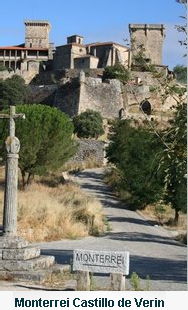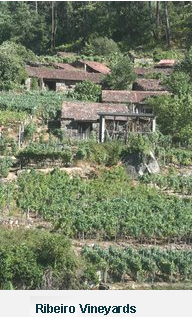|
The best
areas in Spain to discover the sublime Spanish native varietal
white wines is Galicia, a cluster of the northwestern provinces
in Spain.Their native varietals contribute to refreshing,
often terroir-laced, high quality white wines as discovered
by our American panelist food & wine writer Gerry
Dawes during his travel through this region.
The Natives: The best
areas in Spain
to discover the sublime Spanish native varietal
white wines is Galicia, the
northwestern provinces of Spain.
In addition to the well known Albariños from
Rías
Baixas , white
wines from the other Galician regions, are now vying
to become international white wine contenders. Although
some of the blends include albariño grapes, many producers are increasingly confident
with their home-grown varieties, such as treixadura
(Ribeiro and Rías
Baixas), godello (Valdeorras, Ribeira Sacra and Monterrei) and loureiro
(Ribeiro and areas of Rías
Baixas along the Miño River).
These native varietals contribute to surprisingly refreshing,
often terroir-laced, high quality white wines that can be exceptional
food companions.
Ireland
of Spain:
Because it is rainy and emerald-green for part of the year,
has deep Celtic roots and boasts a very long, often
breathtakingly beautiful Atlantic coastline notched with
deep, fjord-like inlets, Galicia
is often billed as the Spanish equivalent of Ireland. Its people even share the
Irish love of potatoes. But unlike the Emerald Isle, Galicia’s more southerly latitude affords the sunshine necessary
to properly ripen wine grapes, in most years.
.
The Vineyards: Because of its high rainfall--some
63 inches annually in Rías Baixas
and just under 40 inches in most other Galician D.O.s,
there is considerable humidity. However, vines are trained
on tall wire trellises anchored by granite or concrete posts.
Growing grapes several feet off the ground, high enough
for vineyard workers to stand upright beneath the clusters,
also allows for air circulation that ameliorates the effects
of humidity-nurtured diseases such as mildew. The leaf canopy
shades the grapes from over-exposure to the sun as well,
a practical expedient because Galician summers historically
can bring some surprisingly hot days — now being exacerbated
by global warming. Even though Atlantic waters can be quite
bracing and bring refreshing breezes to the vineyards, the
climate is actually warm enough to support some very popular
summer beach resorts.
The Tasting Trip: A tasting
trip through Galicia in early August provided a refresher
course on the progress of the native varieties in each of
Galicia’s five denominaciones
de origen: Monterrei,
Ribeiro, Rías Baixas,
Ribeira Sacra and Valdeorras.
I encountered considerable progress since my last major
trek in 2002 and a Rías Baixas sortie in 2004. In the
case of several estates, I was pleasantly surprised by either
world-class "made" wines or evolving wines that
would soon fulfill that promise. On my previous visit I
flew into Santiago de Compostela,
the famous monumental city at the end of the Camino de Santiago
(the medieval pilgrimage route that runs from France
down into the Iberian Peninsula and then some 500 miles
across northern Spain. This time,
however, I opted to drive in from the Ribera
del Duero in Castilla
y León to for a first visit Monterrei,
a small DO comprising some 1,650 acres of qualifying vineyards
located just north of the Portuguese border in the eastern
mountains of Orense province.
 Monterrei:
I was drawn to Monterrei by one
particular adega — as bodegas are called in Galicia. Gargalo, the producer of Terra do Gargalo,
a light, racy, mineral-laced, but nicely fruity wine that
Iberia Airlines serves its business class passengers. Gargalo
is located in Verín, a quaint,
sprawling town that is watered by the Tamega River
and located less than ten miles north of the Portuguese
border. Mountainous terrain, denuded of vegetation by widespread fires of suspicious
nature that have plagued Galicia for the past several summers,
surrounds the town. On a high promontory outside of town,
with spectacular views overlooking Verín,
the vineyards and the sweeping Val de Monterrei,
sits the striking Acrópolis de Verín, a complex that
includes the 15th-century Castillo de Monterrei,
a Renaissance palace and the medieval Gothic Santa María
church. A few hundred yards away, on the opposite promontory
with superb views is the rustic former Jesuit convent that
is now the comfortable Parador de Turismo, the hotel where
I make base while touring the region’s vineyards. Monterrei:
I was drawn to Monterrei by one
particular adega — as bodegas are called in Galicia. Gargalo, the producer of Terra do Gargalo,
a light, racy, mineral-laced, but nicely fruity wine that
Iberia Airlines serves its business class passengers. Gargalo
is located in Verín, a quaint,
sprawling town that is watered by the Tamega River
and located less than ten miles north of the Portuguese
border. Mountainous terrain, denuded of vegetation by widespread fires of suspicious
nature that have plagued Galicia for the past several summers,
surrounds the town. On a high promontory outside of town,
with spectacular views overlooking Verín,
the vineyards and the sweeping Val de Monterrei,
sits the striking Acrópolis de Verín, a complex that
includes the 15th-century Castillo de Monterrei,
a Renaissance palace and the medieval Gothic Santa María
church. A few hundred yards away, on the opposite promontory
with superb views is the rustic former Jesuit convent that
is now the comfortable Parador de Turismo, the hotel where
I make base while touring the region’s vineyards.
Adegas
Gargalo is a small winery with a chic, modern cubist
design that befits owner Roberto Verino,
a Spanish fashion designer and Verín
native. Located just down the hill from the castle and the
parador, Gargalo is set amid sloping vineyards planted primarily with
the native white grapes treixadura,
godello and dona blanca; and native red varieties arauxa,
mencia and bastarda
(some wineries here also have the equally ill-named monstruosa,
a white grape).
There is also a fascinating experimental
vineyard planted with a wide variety of primarily white
grapes that are described to me by Rosa Salgado,
Gargalo’s shy, but informative
enologist, who leads me on a tour of winery and vineyards.
She explains that the trellised main vineyards, now some
20 years old, are predominately planted in treixadura,
godello and mencia.
Back in the winery, Roberto Verino’s
status as a top designer is underscored by the large blowups
of models wearing his clothing juxtaposed against horizontal
Bucher presses and large blowups of Gargalo
wine bottles.
Wines of Gargalo:
Although I had tasted a couple of previous vintages of the
Terra do Gargalo white wines at 35,000 feet, this would be
my first encounter with them on terra firma. In the tasting
room, Salgado pours two whites that had been opened the
day before and refrigerated (I wonder if American wine writers
don’t rate freshly opened bottles?). The Terra do Gargalo 2005, a 50:50 blend of treixadura
and godello that is left
on the lees to pick up flavor, was still fresh, however,
and showed some sweet floral, tropical fruit and baking
spice flavors, balanced by palate cleansing acidity and
moderate alcohol (12.5 percent); Terra do Gargalo
Clásico 2005, a blend of 50 percent treixadura,
30 percent godello and
20 percent dona branca, was
still fresh and lively, too, with even more bracing acid
and distintive spice, almond and mineral notes. (A Terra do Gargalo 2004 tinto, made with 50
percent mencia and arauxa,
a grape Salgado calls "tempranillo
de Monterrei," was a spicy, raspberry- and currant-laced,
serviceable red in need of a few more months bottle aging.)
 Ribeiro
D.O.: About an hour northwest of Monterrei
lies the Ribeiro DO, with its production of 85 percent whites, made
from 7,500 acres of vines in 13 municipalities in western
Ourense province.
Some of the best producers are located around the captivating
medieval town of Ribadavia,
located some 20 miles southwest of Ourense,
the provincial capital. Ribadavia
is a fascinating trip back in time that counts among its
attractions the 14th-century castle of the Counts of Ribavia,
a 12th-century transitional romanesque church, an evocative medieval former Jewish quarter
and substantial remains of the town’s old walls overlooking
the Avia and Minho
rivers, the latter of which, a few miles to the southwest,
flows on to form the border with northwestern Portugal. Ribeiro
D.O.: About an hour northwest of Monterrei
lies the Ribeiro DO, with its production of 85 percent whites, made
from 7,500 acres of vines in 13 municipalities in western
Ourense province.
Some of the best producers are located around the captivating
medieval town of Ribadavia,
located some 20 miles southwest of Ourense,
the provincial capital. Ribadavia
is a fascinating trip back in time that counts among its
attractions the 14th-century castle of the Counts of Ribavia,
a 12th-century transitional romanesque church, an evocative medieval former Jewish quarter
and substantial remains of the town’s old walls overlooking
the Avia and Minho
rivers, the latter of which, a few miles to the southwest,
flows on to form the border with northwestern Portugal.
Vines and Wines of Ribeiro:
As close as any Galician wine to being the Spanish equivalent
of France’s Muscadet, the wines of Ribeiro,
because of the climate, which averages 37 inches of rainfall
and just over 1,900 hours of sunlight annually, have historically
been lean and razor-edged; recently they have become increasingly
richer, but still never overblown or heavy. Grown in granite-laced
soils, often with alluvial deposits of stones and gravel,
Ribeiro’s officially "preferred"
white grapes are treixadura,
godello, albariño,
jerez
and torrontés, yet loureiro,
macabeo (viura),
albilla, and the experimental variety, lado, are also permitted.
Overcropping
for high production levels kept these reasonably priced
native wines from achieving their full potential in the
past. But in recent years, the rising quality levels of
Spanish white wines in general have begun to lift all the
vino blanco boats to a higher tide, Ribeiro
being a notable example. In addition to racy acidity and
better fruit flavors, many of these wines also express a
classy mineral quality. They are delightful with mollusks
(especially raw oysters and clams), crustaceans and fish.
More than once on this trip (and also in Madrid
and New York),
I tasted solo and with meals several very accessible, reasonably
priced Ribeiros, all of which were delicious, balanced and refreshingly
low (for the present times) in alcohol.
Emilio Rojo,
a former engineer with a reputation for eccentricity, is
generally recognized as the star of the Ribeiro. Several years ago, Rojo
returned to his native Galicia
to make some 9,000 bottles of wine annually from five acres
of old, low yield vines hugging terraced hillsides. A blend
of 55 percent treixadura,
15 percent loureiro,
10 percent lado, 10 percent albariño
and 10 percent torrontés,
Emilio Rojo’s eponymous wine displays racy acids, moderate alcohol
and exotic flavors of orange, lime, tropical fruit and spice;
its haunting finish is laced with minerals and is not marred
by oak.
Also from Ribeiro,
Viña
Meín, made from 80 percent
treixadura, 10 percent godello,
5 percent loureiro, plus
traces of albariño, torrontés
and lado, is a bracing
wine with substantive pear and melon flavors, and a long
mineral finish; the wine proved a fine companion for grilled
prawns and small, flash-fried red mullets at Rafa
restaurante in Madrid. The inexpensive
Bodegas Campante Gran
Reboreda (80 percent treixadura,
10 percent godello, 10
percent loureiro), made by the same company as Morgadio Albariño
in Rías Baixas,
is fresh, lively, minerally and
a perfect food companion. Even the wines from the region’s
very large Vitivinicola
del Ribeiro, the 70,000-case
Viña Costeira
and the 85,000-case Pazo,
can be delightful with tapas and
Galician dishes such as pulpo a la gallega (steamed octopus
with paprika, olive oil and sea salt).
.
|